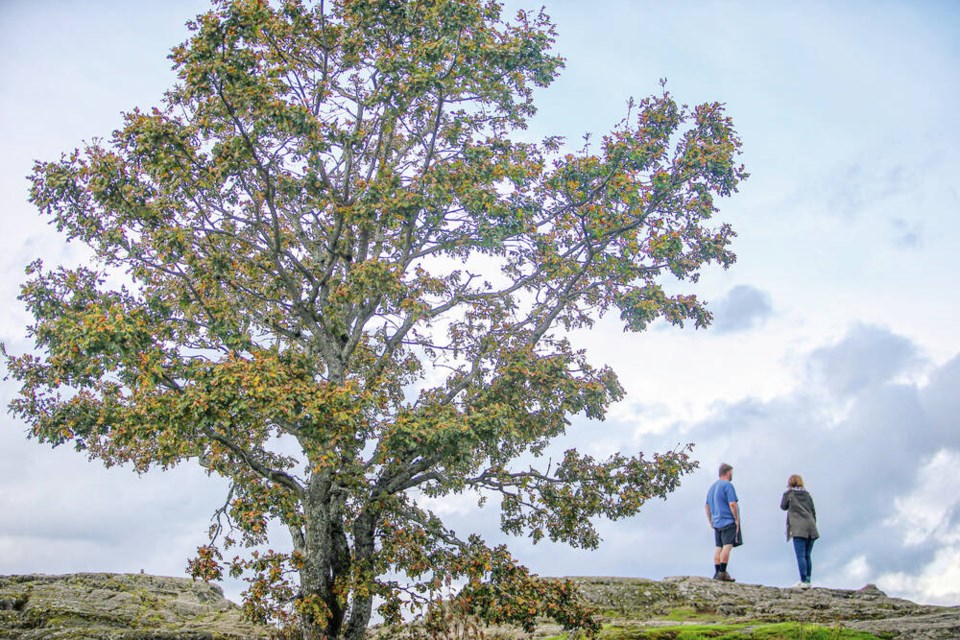It’s been 20 days since the last significant rainfall in the capital region and the millions of trees around our homes, streets and parks are starting to feel some of the stresses of drought.
“Trees like a cycle of moisture and dryness,” said aborist Dan Sharp of Davey Tree Experts — typically, they regulate the uptake of water and nutrients to ensure their own health.
But during extended dry periods, the movement of nutrients can slow and even stop. The tree can suffer and temperatures in its canopy can rise, causing the leaves to shrivel and brown and, in some cases, drop limbs.
Sharp recommends a good soaking for larger trees about every 10 days to two weeks that reaches 20 to 25 centimetres into the root zone. Following Capital Regional District watering restriction guidelines, that’s about an hour using a sprinkler or soaker hose.
Too much watering might cause root rot and fungus problems, said Sharp, who also recommends surrounding the trees with coarse mulch, such as wood chips, that shades the soil and slows evaporation.
People can also help trees by avoiding compacting the soil around the base. “It’s really important to limit traffic around trees, like playgrounds and vehicles, because water just runs off and doesn’t get to the roots,” he said.
Extended periods of drought can cause browning of foliage and even hydraulic failure, the sudden dropping of limbs.
Sharp said long dry summers are starting to take their toll on some native species, such as the grand fir and the Western red cedar, which are showing signs of browning in extreme heat. Garry oaks and Douglas fir are also starting to be affected, he said.
Peter Constabel, chair of the biology department at the University of Victoria, said long periods of little precipitation can cause trees severe stress. These dry spells — including a 53-day stretch in Victoria last summer — can make trees more susceptible to fungi and insects and increase hydraulic failure, where large branches or limbs simply snap off.
A horse chestnut tree in the Gorge Tillicum neighbourhood lost one of its large limbs on Tuesday morning, falling onto a vehicle and causing significant damage. The City of Victoria said the incident was not related to the heat wave, but due to a “bark inclusion” — when two branches or stems grow too close together in a V formation.
A city spokesman said during heat waves, watering of young trees is increased, and staff monitor them to minimize losses. City staff also monitor large-canopy trees for stress and decline.
“One hot, dry summer will generally not significantly harm a large, healthy tree — they’re designed by nature to handle stress events,” said a city statement. “However, year over year drought stress can cause a tree to decline.”
Staff monitor large trees in our inventory and supplement water where and when possible.”
Experts say successive years of drought and stress can eventually cause failure in limbs or to the whole tree.
Some say limb failures are triggered by high humidity within the tree’s canopy, which leads to a surplus of moisture that weakens the tree’s structure. Others believe it stems from an internal issue, such as bacteria.
Sharp also said fruit trees can be vulnerable to sudden limb loss, as they can overload themselves with new growth in the spring and can’t generate enough wood to support the growth. During dry spells, the limb breaks under the weight.
A study by the U.S.-based National Science Foundation indicates some tree deaths occur because of carbon starvation.
During drought, trees close their stomata — the minute openings in the epidermis of leaves — essentially starving themselves by blocking the entry of carbon needed for photosynthesis. Trees then have to rely on stored starches and sugars until the drought ends.
The study said if a tree loses too much water too quickly, an air bubble forms, resulting in “hydraulic failure,” because it can’t transport water from the roots to the leaves, causing it to dry out and die.
The scientists found that hydraulic failure is almost always a death knell for a tree, while carbon starvation is a contributing factor about half the time.
While arbutus and Garry oak have adapted to lower precipitation in the summer months, they still show signs of extreme stress. Others like cedars that rely on moisture are suffering.
The Western red cedar — B.C.’s provincial tree — struggles in dry conditions, showing signs of “flagging,” or browning of its foliage. Over the years, large stands have died off on the east coast of the Island, although it does much better on the Island’s west coast.
>>> To comment on this article, write a letter to the editor: [email protected]



